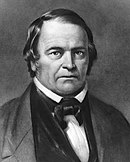John T. Walsh | |
|---|---|
| Occupation(s) | Founding member of the Advent Christian Church, minister |
| Part of a series on |
| Adventism |
|---|
 |
|
|
John T. Walsh was a Millerites who after the Great Disappointment, led a group of Adventist Millerites who believed that Christ had indeed returned on October 22, 1844 only invisibly and they further believed that the Millennium had begun on that date. This group organized as the Life and Advent Union in 1863, which later became part of the Advent Christian Church.
In 1845 the last conference of the Millerites as a body was held in Albany, New York, on April 29. After this conference, the Millerite movement split into three main factions. William Miller, and Himes both affiliated with the first faction and this group continued to believe in the imminent return of Christ, the immortality of the soul and Sunday worship.
The second faction spiritualized Miller's prophecy concerning the Second Advent. They contended that Christ had indeed returned on October 22, 1844 only invisibly and they further believed that the Millennium had begun on that date. John T. Walsh was one of the principal leaders of this faction of Adventism, which taught that the wicked would not be raised at the Second Advent but only during the Millennial Reign. John T. Walsh, who began preaching in Wilbraham, Massachusetts, began teaching the doctrine that their will be no ressurection of the wicked. John T. Walsh, was then an associate editor of the Bible Examiner, an Adventist periodical published in New York City (whose editor was George Storrs). He broke away from the Millerites in 1848 to form the "Life and Advent Union," because he held that there is to be no resurrection of the wicked; and that this earth, not heaven, is to be the eternal abode of the righteous. [1] Rejecting the "Age to Come" idea that there would be a chance for those who had never heard the gospel during their lifetime, Walsh did not believe that God would resurrect the unjust merely for the pleasure of condemning them to death. God was too "loving" for that, Walsh reasoned, and therefore the unjust dead would simply not be resurrected. Eternal life could be had only through Christ.
Subsequently, so much debate occurred with Walsh and Storrs opposing the main body of Adventists that on August 30, 1863, a separate denomination, the Life and Advent Union, was formed which later merged with the Advent Christian Church.[2]